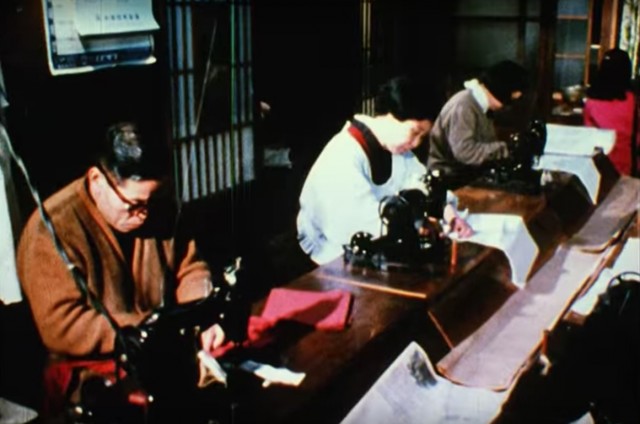
Here’s a video, perhaps in the same grade-school documentary series as the one about Japanese industry in the 1970s. It has no cars, but you can still learn a thing or two. In particular, there’s a scene showing a family-owned sewing business (6:19 in the video below the fold). In the small home, a family might live in one room, while a “factory” occupied another. It is difficult to describe the scale of such an operation without visuals.
“The family contracts with big companies to make or assemble parts of a product.” Many times, this would have included contracts with large automotive companies. Order a few thousand widgets from the Yoshimuras, order another few thousand from the Watanabes. They would be identical and built to spec.
Here’s an article from 2009 Japan Times article about Nissan Chuzousho Ltd., a Nissan parts supplier that was the last surviving beigoma company in Japan. Said the 62-year-old owner Shunichiro Tsuji, “In my city, Kawaguchi, within just a one- or two-km radius, we can make the parts for, and put together, anything: a truck, a plane, or a robot. There are hundreds of tiny factories like mine that manufacture the most important parts for any product you can think of. Even a space rocket!”
Family-owned companies like this were key to the fabric of Japanese culture. It may seem at first incomprehensible to western businesses. Why not just buy 200,000 widgets all from one big company?
It was because of, as this Australian National University report says, the traditional Japanese idea of a business existing for society. That’s a reversal of western, especially American, thinking, where corporations feel no obligation to be good citizens. Japan, as a whole, understood that the more people that were kept employed, the stabler society was, which in turn kept the the economy churning and crime off the streets.
It wasn’t just a one way street, either. The large companies maintained personal relationships with the suppliers. This included education and training, sharing predictions of where the market was going. If the prices got too expensive and the automaker had source parts from another company, they’d find something else for the family to make rather than just drop the contract.
Sadly, Nissan’s network of 3,000-plus suppliers was one of the first things Carlos Ghosn all but obliterated when Renault took a controlling stake in Nissan. That, and lifetime employment. The western model was adopted and soon other Japanese makers had to follow suit. While the old system still exists, it has been much diminished, even at companies like Toyota.
It’s true that Nissan had many other inefficiencies and problems that had pushed them to the brink of bankruptcy. Perhaps it was always going to be the case that Japan would have had to change eventually. In any case, part of Japanese culture had been lost. That is why today Nissan is described by some Japanese industry watchers as “a French company with a Japanese name.”
Thanks to YouShouldVisitJapan.com for the video!






Small family companies can still be found in numerous industries across Japan. There’s even a few regular TV programs on their unique products and machines, with one having the usual panel of talento trying to guess what is being made. Yet another shows in great detail how bamboo umbrella, mochi snacks, or paper clips are made. I cannot imagine such programs making air-time in the West.
Do not even think about ‘Snack Wars’; which combines the above with food, AND a competition, AND talento.
If you’ve the time, exploring the back alleys of Japan results too in remarkable sights, the one man shop making tatami in a wealthy neighborhood, small cookie factories, little machine shops, meishi and hanko makers, and many other local manufacturers that in other countries would have long expired.
While certainly less than there used to be, some are even finding new staff, or corporate drop outs taking up the trades. Yes, you guessed it, a TV program recently highlighted a young banker who now trawls the streets on his bicycle selling tofu…
I heard about this on JNC before, people who made parts for Mitsubishi cars in the home they owned. (There is not a lot like this here in North America).
This may be off-topic, but this is one of the reasons that I love the show, Wheeler Dealers. I know that most (all?) “reality” shows are mostly scripted, but at least they seem to use a lot of individual craftsmen/women and little shops that specialize in restoring a steering wheel or restoring dashboards or one that specializes in making some otherwise-non-existent rubber bits, etc. Those shops still exist in every country but they’re getting to be more rare, no question about it. Like small, family-owned farms instead of corporate farming.
This is a great video, thanks for putting this out there.
Sadly, Nissan’s network of 3,000-plus suppliers was one of the first things Carlos Ghosn all but obliterated when Renault took a controlling stake in Nissan. That, and lifetime employment.
Carlos Ghosn had to change this outdated and inefficient form of Corporate socialism. A guarantee of lifetime employment and thousands of independent suppliers translates into high prices that consumers will not pay on the open market. A corporation has to remain competitive to stay alive and by merging Renault with Nissan, huge savings could be realized in parts sharing. This makes both brands relevant and stronger and not a footnote of failed auto companies. The world changes and companies and individuals must change with it. To blame the corporation for not being good citizens by not holding on to the past sounds good but it is the consumer who will eventually decide the winners and losers.
It all depends on perspective. In some cultures paying a worker $1 an hour working 20 hours straight is an acceptable business practice. In the US, the people and the market have made a choice that that isn’t acceptable. Some companies stay, some go to countries where they can get cheap labor, causing unemployment here.
Toyota and Honda were able to survive and profit while under the traditional Japanese system at the time of Nissan’s near-bankruptcy. Nissan had problems beyond lifetime employment and family-owned suppliers that made their situation worse. Ghosn had his ideas about what to change for the quickest path to recovery. He might have been right. We’ll never know. I’m not in favor of lifetime employment, by the way, but I view it as a cultural value.
I think it depends on the industry – neighborhood TV repair guy (any of THOSE left?), or custom cabinet or furniture maker vs. building cars.
I’m not a fan of guaranteed, lifetime employment, either, but the U.S. trend toward having employees training their replacements, then giving the original employees the heave-ho is garbage.
I wasn’t aware that Nissan was close to the edge… Maybe THEY should have paired with Chrysler, as Mitsubishi did in the ’70s and ’80s. Of course, I wasn’t aware that Renault was the CONTROLLING interest, either – kind of explains the styling of the Leaf.
I don’t know if Chrysler would have helped. Every merger they’ve been involved with in the last 40 years has been doomed. And remember, Renault did partner with AMC and as a reward they had to leave the country.
I don’t know for certain, but I’m pretty sure the Leaf did not have Renault’s input in styling. The Japanese are perfectly capable of putting out an insanely odd looking car (new Prius). It is, however, a result of Ghosn/Nissan wanting to be a global giant and designing a single car that will fit every market.
“merging Renault with Nissan, huge savings could be realized in parts sharing. This makes both brands relevant and stronger and not a footnote of failed auto companies.”
Having worked for a number of car manufacturers I know for a fact that losses are caused by over-optimistic views on the market and the market-shares that could be acquired:
For instance, when Mazda revived the market of compact roadsters, most competitor brands marketing department decided they also needed a similar product to keep their customer base happy. What no-one wanted to see was the simple fact that the market for such vehicles will always remain limited.
In the end more cars in that niche end up being just built but never sold. With every fashion, be it hot hatches, roadsters, covertibles or SUV’s we see the same story happening all over again.
That, and the fact that every manufacturer feels they need a full size product line-up, even if there is no customer base to support it, costs them dearly. Those costs have to be recouped or the company is out of business.
Who pays for it? customers, in part, but mostly the workers and suppliers/subcontractors
Great article! I really enjoy the Japanese cultural pieces on JNC; they add another dimension to my appreciation for Nihon steel.
I just can’t imagine living that “tight.” Small living area, AND workspace in the same small residence…
Out in the country (the article about the farm houses), I could see it, but in a crowded city – wow…